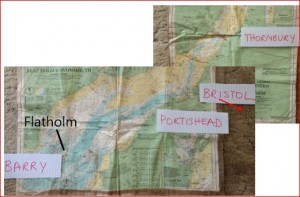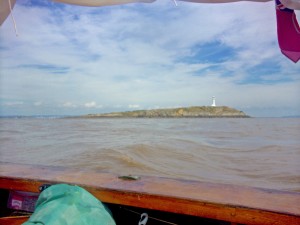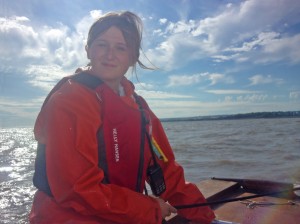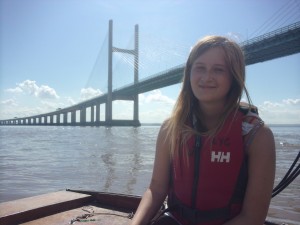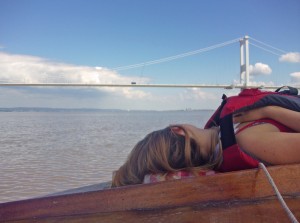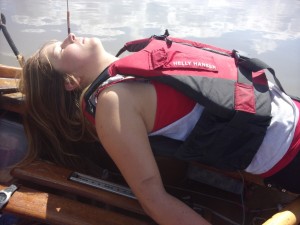A TRIP TO BRISTOL WITH MY DAUGHTER.
by Annabel Bowker-Dance
Lydney Yacht Club, based in the Severn Estuary in Gloucestershire, run a 9-day Summer Cruise around the Bristol Channel. For many years there have been a number of wayfarers in the fleet, and mine was one, she was a 1960 wooden Mk 1 boat – just like the one Frank Dye sailed: Sometimes mine was the only open boat, and sometimes it was one of many.
One year my daughter Rachel crewed for me, but this year the forecasts were for higher winds than we actually got, and windiness in the fleet was greater than normal. We usually made it at least to Watchet on the Somerset coast (one year we were marooned there for 3 nights with gales, enjoying the steam railway, eating too much and of course spending too much time in the pub). Some years, having reached Cardiff, life became just too comfortable and forecasts too worrying and people were loth to move on.
But this year, having got to Barry (of Gavin and Stacey fame), we decided to go back upriver and take in Bristol on the way home. Going to Bristol from the west is easy as you can do the whole sail including the River Avon on an incoming tide arriving in time for the lock gates to open, this happens from one and a half hours before high water up until half an hour before high. Sailing from Bristol to Lydney (or Thornbury), however, requires leaving on the ebb tide (locking out before high water), beaching somewhere around low water and coming up to Lydney to arrive at or around high water – it’s a 12 hour trip.
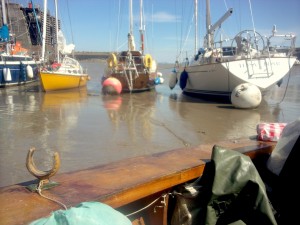
Dried out in Barry harbour. I expect we were brewing up and enjoying the sunshine. The yellow yacht ‘Suomi’ was one of our fleet
We left Barry after lunch, at around hour after low water. Most of the time there is water in the harbour, and it is one of the few places where you can enter and leave near low water. Many of the harbours in the Bristol Channel are drying harbours, and, though lovely, they involve anchoring off as almost all sailing is done with the tide. Sometimes you can leave an hour or two before and get out into the main current just in time for it to turn in your favour – there are back eddies all along the sides of the channel and these can also be used to good effect.
This was the only year I sailed with family; it was so much better with proper crew. Coming out of Cardiff a couple of days before Rachel hadn’t bothered zipping up her dry suit. I thought the days of having to dress her were over, but apparently not! With a daughter you can find that she knows it all, and that being Mum, I could know nothing. That could be hard work when something really needed to be done, but perhaps I’m being too harsh – she could sometimes really do the business. She was fit and strong and when she could see what to do, she would do it well.
The day started out sunny and then the rain came, just a shower, but we had a lovely run across the channel towards Avonmouth, highly visible at sea due to its many wind turbines. The Bristol Channel is quite industrial, and though beautiful in places many of the navigational features are power stations, bridges and other large, man-made features – as well as the islands and hills.
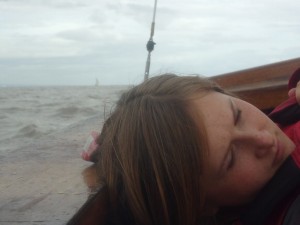
The wayfarer is full of comfortable places to have a snooze – here she’s lying on the thwart with her head on my home-made foam cushion covered with plastic table cloth
The main feature of the Bristol Channel is the strong tide. Up to 7 knots under the Prince of Wales Bridge, the tide has the following effect on the sailor: if the wind is with the tide, it will be much, much calmer. The prevailing wind is SW, so sailing eastwards as we were on this trip is usually a much smoother ride. The strongest tide will be found in the deep-water channel, and there are many large sandbanks which can be rougher and will dry out quickly on an ebb. The waves tend to be short, we call it ‘lumpy’ because you just bash down them, but I find it is a better motion for seasickness than I have found, for example, off Plymouth. Buoys and other fixed objects will have a bow wave and a wake behind and lean strongly into the tide. It’s important not to be driven on to them, they come at you quick! If you are not using a GPS you have to watch the land carefully as well as checking your boat speed through the water, if the tide has turned, you may be going backwards – and when you approach a harbour it is very important not to overshoot as you can rarely get back to the entrance against a swift tide.
Having reached Portishead we continued on the flood tide up the River Avon and under the Clifton Suspension Bridge, in Bristol.
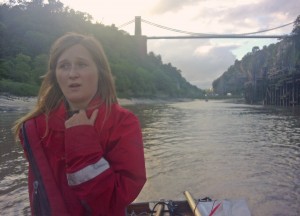
Rachel was my daughter, and so she knew best. ‘It’s like this Mum….’ she was saying as we were towed under the Clifton bridge
After a while the wind dropped, there are a lot of cliffs in the Avon and it’s full of wind shadows. I was exhausted by now and I was grateful to accept the offer of a tow from one of the yachts in the fleet.
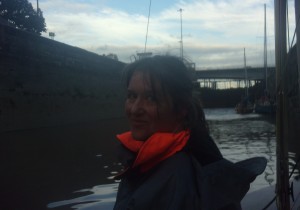
It was getting dark an hour before high water when we locked into Bristol. There’s me and two of our cruisers ahead in the dock. The road bridge ahead had to swing open for our masts, causing traffic chaos.
Cruisers are great to have around on an adventure like this as they often offered a berth for the night, and Rachel was jolly good at chatting people up when needed. (Once we were towing the Wayfarer and stopped at a motorway services to pump the trailer tyres, but instead the air all came out and the tyre came off. While I had a spare wheel I had not been able to get the necessary imperial spanner, but Rachel saved the day by going inside and finding an AA man who she had no trouble persuading to change our wheel.) Whilst cruisers were good for a tow and a berth, sometimes the dinghies decided to break free and, with their negligible draught, could explore smaller inlets where the big keels couldn’t (or wouldn’t) venture.
So this year, we slept on the yachts. A previous year when we had visited Bristol it was raining very hard and there was nowhere to pitch a tent, we’d ended up sleeping in the harbour toilets which had the light on all night. No wonder we need to lie down at sea!
We rowed out of the Avon the next day but in spite of the favourable current we couldn’t make progress with a strong head wind, which funnelled down the river. We hoisted the sails and started tacking and that worked much better. After spending low water in Portishead we carried on up river towards Thornbury Yacht Club:
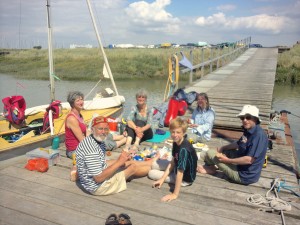
At Thornbury Sailing Club: from left then clockwise: Kirsty and Sue (in Kirsty’s wayfarer), me, Steve (my husband on an exceedingly rare sailing trip), David (Sue’s son) and Peter Lockwood in his yacht Suomi. Rachel took the picture.
Pontoons are the wayfarer’s friend as they give you a nice big space to sit on and empty your gear out on to. We camped over here at Thornbury before sailing back to Lydney the next day – a great last night of our summer cruise!
I have written a book ‘Dinghy Cruising in the Bristol Channel’ available on Amazon. This book is about the adventures we have had in our club – but you won’t have to deal with any more family angst as I sailed with other people the rest of the time! It’s been a lot of fun and I do hope you enjoy reading it. AB-D



